19 dishes from all over the world that blew our minds in 2023
As food writers, even during leisurely travel, we find ourselves seeking out burgeoning trends, emerging chefs and restaurants to recommend. Although our primary coverage area might encompass Southern California, culinary influences are traded all over the world, and the best way to report on those shifts is to go to the source, whether that takes us to Mexico City, Singapore, Tokyo or beyond.
These are the best meals our food writers had in 2023 that are at least one flight away — from buttery capellini Cantonese at New York City newcomer Torrisi that reporter Stephanie Breijo sneaked in during The Times’ annual Coast to Coast event to shatteringly crispy sweet potato tempura that restaurant critic Bill Addison sampled while studying the links between Tokyo and L.A’s sushi cultures. And, of course, there are the places that we stumbled upon unexpectedly: a stand pairing pulpo a la brasa with crisp white wine in Barcelona’s bustling La Boqueria market, a Kyoto bakery with masterful French pastries, a Filipino brunch in Chicago that’s featured on the Hulu series “The Bear.”
Here are 19 meals that we’re collecting frequent flier miles for, with the hopes of soon eating again:
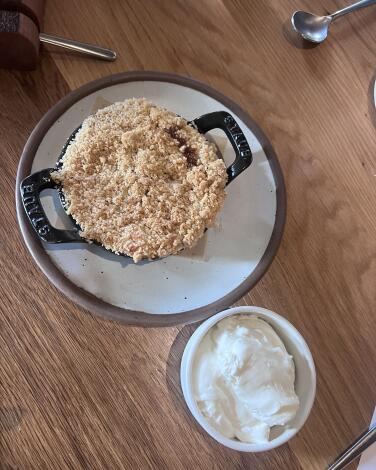
Peach cobbler at Audrey
Weekend brunch was a quiet affair, with just a few small groups spread across the spacious dining room. The entire meal stands out as one of my most memorable of the year, with highlights such as crab and grits crowned with a sorghum-cured egg yolk and an Appalachian-style breakfast plate with fried apples, tomato gravy, Sack sausage gravy, soft-scrambled eggs, hash browns and a buttermilk biscuit.
The standout, however, was the peach cobbler, a dish that we were graciously given courtesy of the kitchen after we informed that another item was unavailable. The miraculously gluten-free dessert arrived in a small cast-iron skillet with a thick brown sugar crumble and just-cooked peaches hidden underneath, with house whipped cream on the side. Although it was unexpected, we had no problem cleaning the plate. The beverage program is treated with similar reverence, with wine pairings available and brunch standouts like a chicory martini and a Bloody Mary with hearth-roasted tomato and smoked squash.
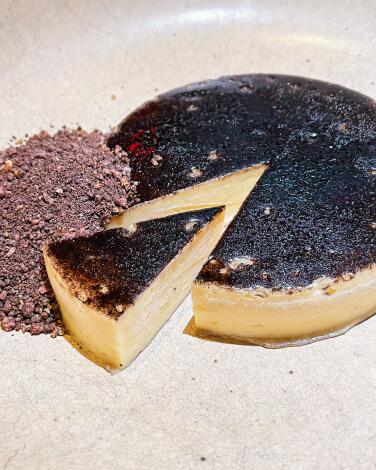
Basque cheesecake ice cream at Bar Spero
He roasts cream cheese with caramelized sugar, which forms the base of both the ice cream insert and the semifreddo: The two textures melt differently at the edge and the center for a confounding bite. Once frozen together, they’re topped with a blend of caramelized sugar and black cocoa to emulate the oven-roasting of the burnt top. Separately, he makes a caramel of black cocoa that’s covered with a crumble of dark chocolate, white chocolate, hazelnut oil and wild rice for texture and nuttiness. It all started as a special with only six available each day. Since the 2022 opening, it’s become one of the restaurant’s signature dishes, with a couple hundred sold a week. Spero says he wouldn’t dream of cutting or changing it: “There’s certain things that I know if I try to pull off our menu, our staff would probably kill me because they know how iconic they’ve become, like the Basque cheesecake.”
Spero is in the process of addressing fire damage to his Michelin-starred Reverie — a reopening on the radar of plenty of food enthusiasts — but the more casual Bar Spero is, in its own right, very much a D.C. destination. Especially for this ice cream.
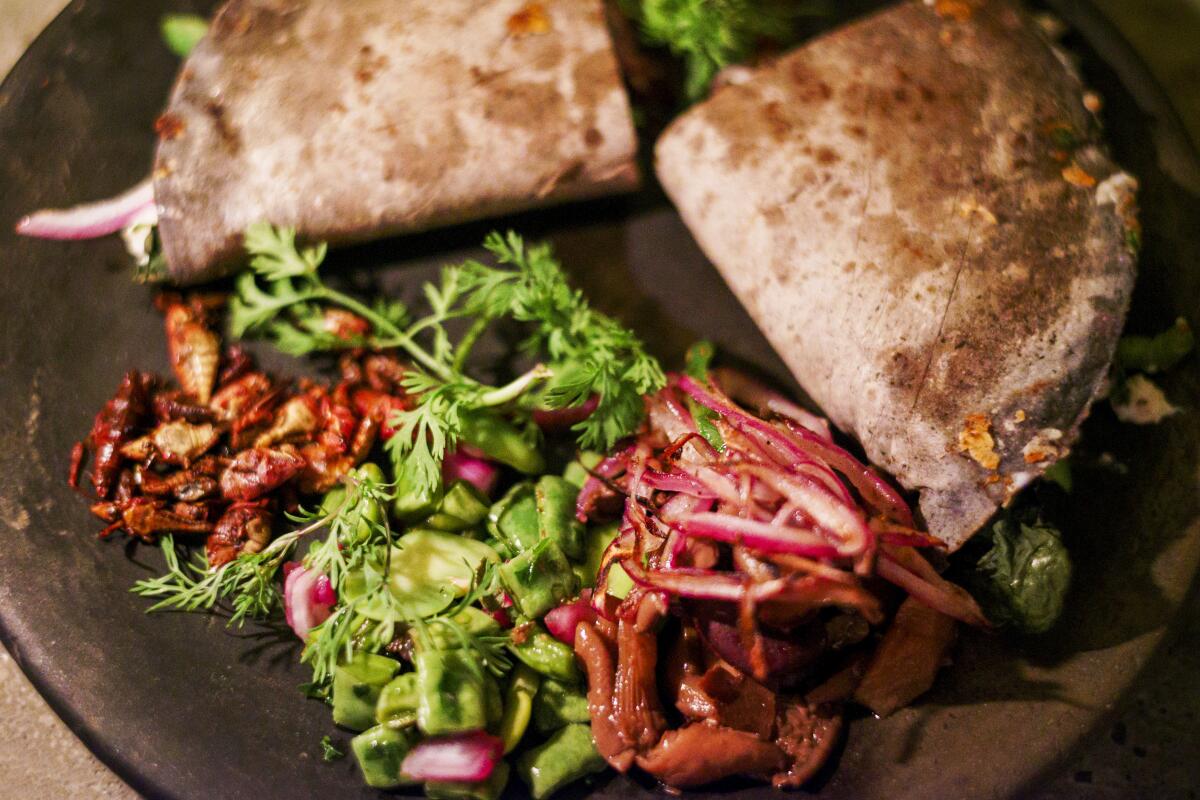
Quesadilla de chapulines at Bósforo
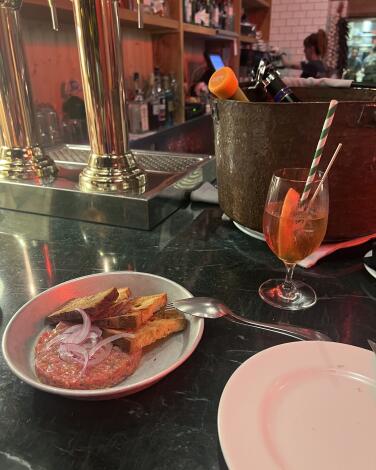
Speck pizzette and steak tartare at Bronzo Bar e Cucina
While Bronzo Bar e Cucina hasn’t achieved the Michelin status of Windsor restaurant across the street, its tapas menu, with seasonal plates and Italian ingredients, is far from a secret. We had no reservation, so we were seated at the bar, but that didn’t hinder our enjoyment of the dim, stylish space. Fresh out of a stone oven, the pizzettes are a must, especially the speck with creamy burrata, sharp arugula and pesto — I devoured all but a slice before I remembered to take a picture. Harry’s steak tartare was another standout, with a simple presentation that features slivers of red onion and slices of buttered toast on the side. The night passes easily with a bottle of Venetian wine.
C/ de Còrsega, 307, L’Eixample, 08008 Barcelona, Spain
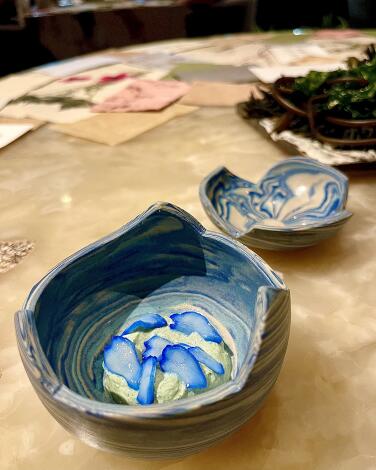
Black Rocks course at Central
Black Rocks, focused on ingredients sourced 10 meters (nearly 33 feet) below sea level, arrives with a platter of seaweed to set the scene, followed by sushi-like lozenges topped not with salmon roe or a piece of uni but delicate circles of sargassum, a kind of seaweed, resting on what appears to be caviar but is actually dehydrated squid ink with a giant squid reduction underneath. On a separate plate, made for the restaurant to seemingly capture wet sand just as a wave has receded into the ocean, is a shell filled with meat from the head and body of a Peruvian blue crab, sweet and complex. And then, inside a ceramic bowl that looks as if someone caught the moment blue dye was dropped into a bowl of water, you find a pale clam emulsion with squid turned an intense blue with an algae ferment and spirulina. With the food comes a fresh-tasting elixir poured from a bottle that reads Momento Baja el Mar, made with seaweed distillate and cucumber that grows near the ocean. This is turned sea-foam green by your server, who spoons a bit of algae extraction into the glass.
You take it all in. The seaweed, the clams, the crab, the squid, the cocktail. Each flavor and sensation feels new. But it’s the combination of otherworldliness and comfort that I remember most from the custard of clam and squid that seemingly could have been sourced from the blue ice fog of Neptune. The emulsion, not as silky as Japanese chawanmushi but just as soothing, contrasts beautifully with the firmer bite of the sliced shellfish and tastes wonderfully of the sea right here on our own planet Earth.
For more on Central, read our profile of chef Virgilio Martinez.
Av. Pedro de Osma 301, Barranco 15063, Peru
Phone: +51 1 242 8515
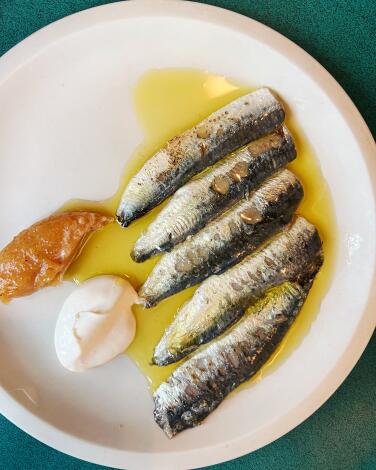
Sardines with smoked crème fraîche at Clamato
80 Rue de Charonne, 75011 Paris, France
Phone: +33 1 43 72 74 53
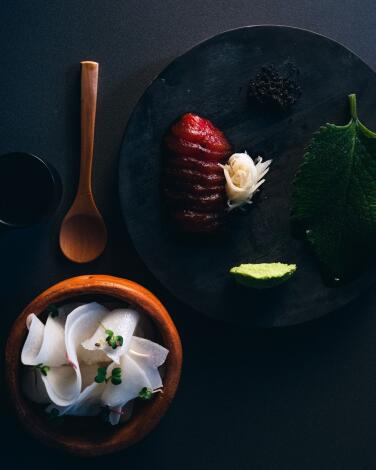
La sopa roja at Diacá
My favorite dish was the first course, which chef Debora Fadul calls la sopa roja, or the red soup. Yes, there’s soup but also two accompanying dishes. I was most impressed by what at first glance looked like fish sashimi, wasabi, a bit of ginger and some kind of leaf. The diner is encouraged to make a taco with the ingredients, using the leaf as a tortilla. I was stunned when I bit into it. What my eyes had just seen didn’t jibe with what was happening in my mouth. The server explained that what I thought was sashimi was actually grilled and sauteed watermelon. The green dollop was a pea puree. The ginger? Watermelon rind. Lastly, the leaf was a Mesoamerican oregano, known as mono de espacio.
It all worked so well together and paired perfectly with the soup, with herb broth and juice extracted from the sauteed watermelon. The savory elixir with a faraway sweetness was comforting. A side dish that resembled sliced cucumber was actually perulero, a pear-shaped chayote or squash native to the country. It’s commonly boiled and used in soups or stews (that’s how my grandmother used to serve it). Here, it was thinly sliced and raw, tasting like a cross between jicama and cucumber. Eating at Diacá was a sensory and emotional experience. It made me nostalgic for those yearly trips we’d take to my grandparents’ home in north-central Guatemala, where we were greeted with a huge pot of beef soup with generous portions of chayote.
Via 6, 3-56 Edificio OEG, nivel atelier, Cdad. de Guatemala, Guatemala
Phone: +502 4007 8164
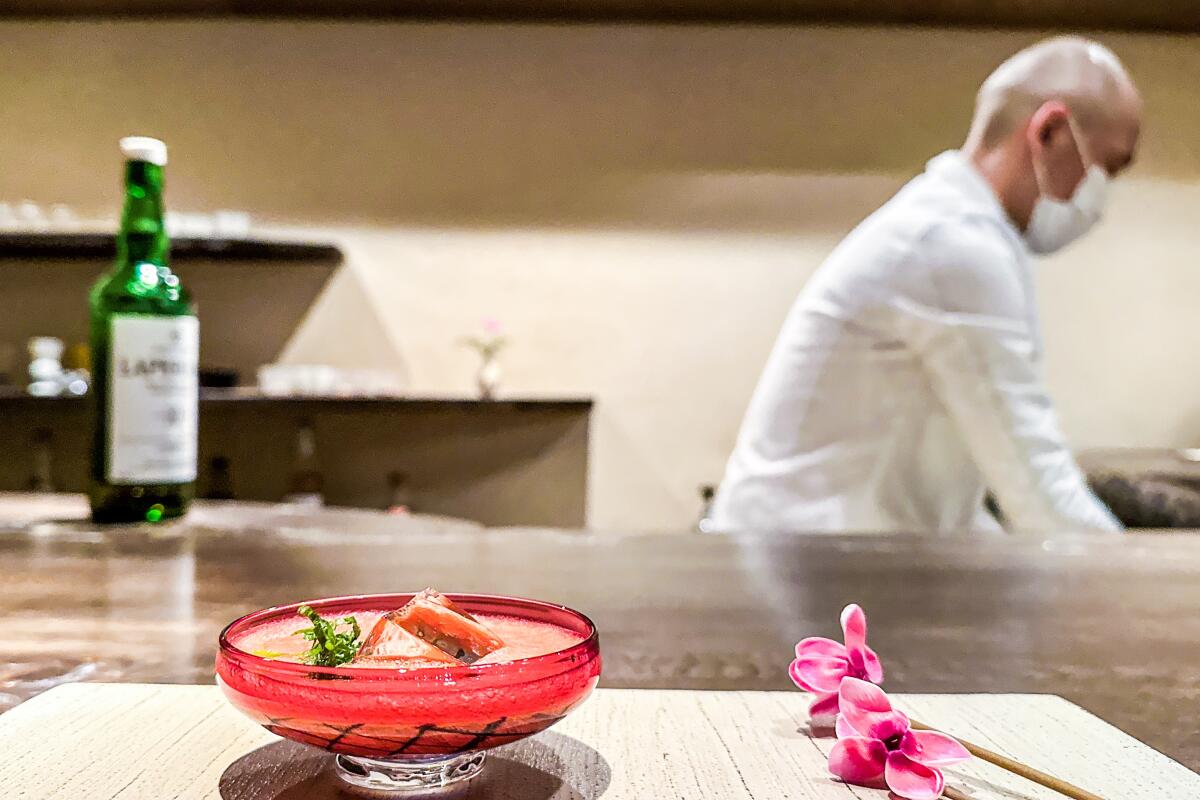
Tomato and Laphroaig cocktail at Gen Yamamoto
A flight of seven small cocktails in March began with Yamamoto vigorously muddling hassaku, a nubbly skinned Japanese citrus in the orange family, and pairing it with Marc de Champagne, a French distillate that’s in the same arena as Italian grappa. It was unlike anything I’ve had before. The day’s creations also included juiced kiwi coupled with soju and sprinkled with matcha, followed by a combination that ended up being the first one I mentioned most to people when describing the whole experience: pureed Momotaro tomatoes spiked with Laphroaig and sharpened with shiso. The tomato absorbed the scotch’s peaty smokiness, and the minty herb cut right through the other dense flavors. I couldn’t imagine how well the trio would unite until my first sip.
By the end, I knew I’d never had a drinking session that more matched my personal tastes. A meditation on fruit served in stunning glassware isn’t everyone’s vibe, but I kept thinking: Couldn’t a talent and an approach like this change the game in Southern California?
1-Chome-6-4 Azabujuban, Minato City, Tokyo
Phone: +81-3-6434-0652
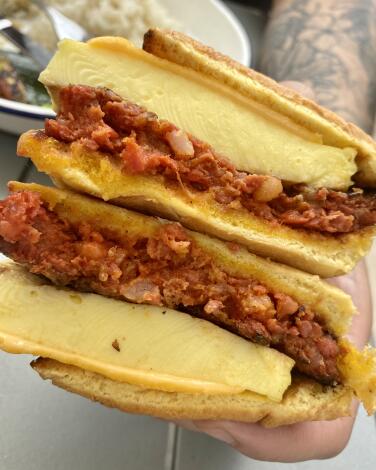
Longanisa breakfast sandwich at Kasama
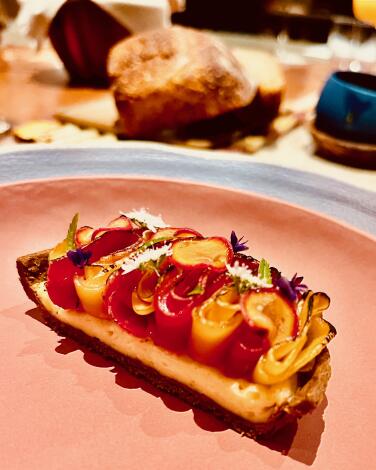
Many tubers at Kjolle
Her restaurant Kjolle, in Lima’s artsy Barranco neighborhood, is housed in the same Casa Tupac complex as Central, the restaurant run by her husband, Virgilio Martinez. Central is also where she found her voice as a chef.
Like most restaurants of its caliber — it was voted No. 1 this year on the world’s 50 best restaurants list — Central has a large international team of chefs contributing ideas filtered through Martinez. Kjolle is a more personal restaurant, easy to love with more accessible a la carte entrees in addition to a tasting menu from a smaller but ambitious team of chefs led by León.
Native Peruvian ingredients, many sourced through Mater Iniciativa, the research project started by Martinez, his sister Malena Martinez and León, are at the heart of the cuisine at Kjolle. So you might see the fruitiness of spongy white pacay seeds, a kind of ice cream bean, paired with luscious fresh scallops or the Andean tuber black mashua baked into bread or a tart. River shrimp and razor clams, flavored with coconut and cecina, are dotted with tiny green spheres of algae hand harvested from a lake high in the Andes — Incan caviar. Instead of presenting this dish as solemn high cuisine, León sends out lettuce leaves so you can make your own delicious wraps, Vietnamese style, to eat with your hands.
But the tart called muchos tuberculos, or many tubers, served early in the meal, is a statement of purpose for Kjolle. With a crust made from the quinoa-like grain cañihua and an intense potato flavor that borders on sweet, it shows that a culinary exploration of one of the world’s most ecologically diverse places can be delicious and fun. You can use a fork. But I don’t think León would mind if you just picked it up in your hand and ate it.
Address: Av. Pedro de Osma 301, Barranco, Lima, Peru
Phone: +51 1 242-8575
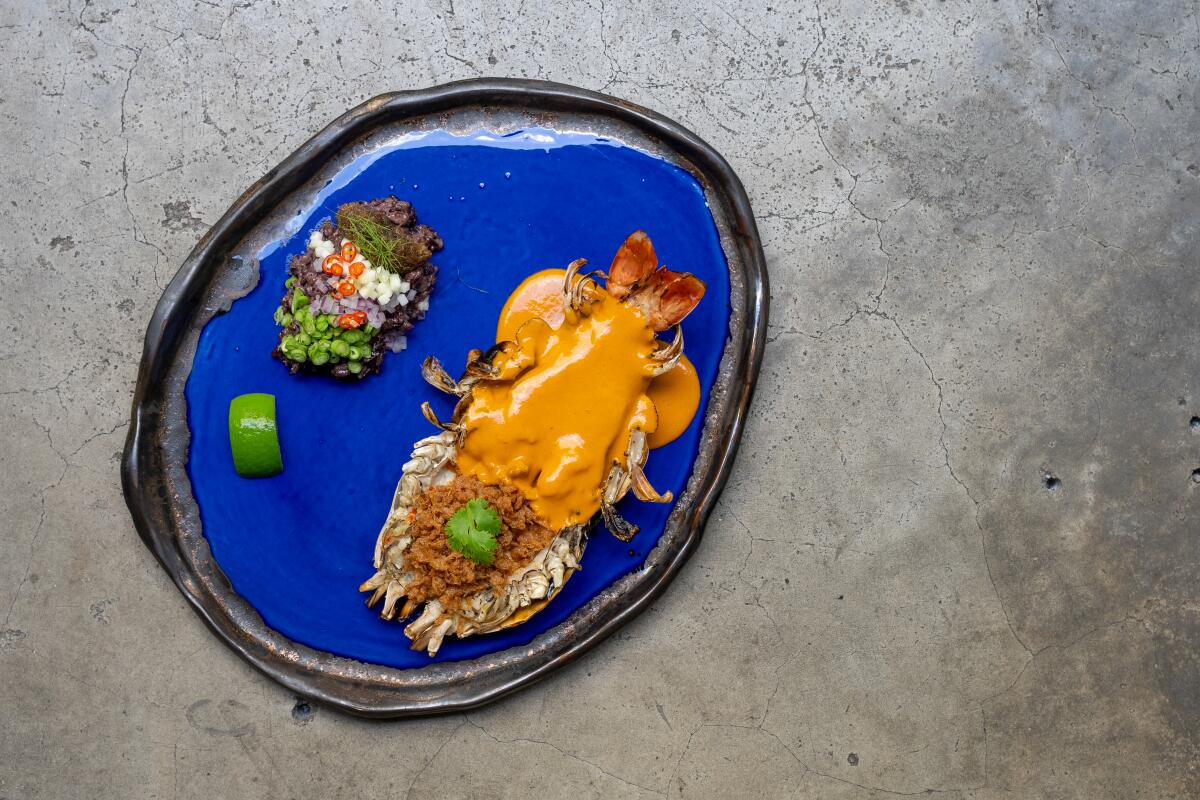
Khao kluk kapi from Le Du
399/3 Silom 7 Alley, Silom, Bang Rak, Bangkok 10500, Thailand
Phone: +66 92 919 9969
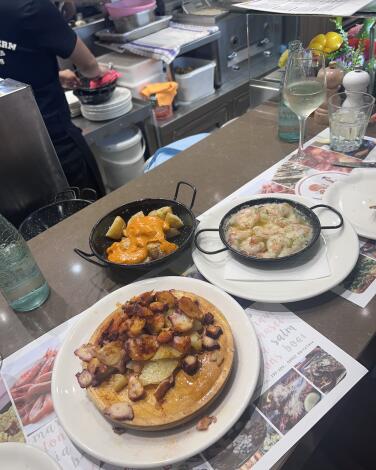
Pulpo a la brasa and patatas bravas at Mercat de la Boqueria
All of that to say that I can’t tell you the exact vendor or stall where I ate life-affirming pulpo a la brasa with saucy patatas bravas and prawns in garlic butter. What I remember most — aside from how a glass of crisp white wine paired perfectly with the plump and briny seafood — is the pleased smile of the woman who worked the stand as she watched my friend and I devour our meals. She was happy to banter with my broken Spanish as she dipped baskets of chopped potatoes into bubbling vats of oil.
La Rambla, 91, Ciutat Vella, 08001 Barcelona, Spain
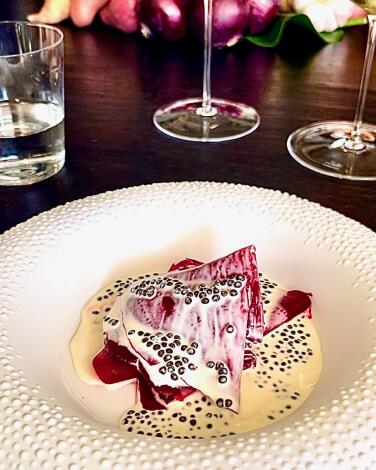
Beets and caviar at Mirazur
Like so much of Colagreco’s food, this dish began in the garden. A harvest of Crapaudine beets — “thought to be the oldest beet cultivar still in existence,” according to Uprising Seeds, “dating back possibly 1,000 years to the time of Charlemagne” — was left in the cellar for two months while the restaurant was closed. Colegreco came back to discover an astonishing concentration of flavor in the dehydrated roots. His gardeners replanted the beets, which grew even larger and more flavorful. When it came time to harvest, Colagreco, as he told Michelin’s Georges Rouzeau, decided to cook the beets in a salt crust to concentrate the flavor even more. The addition of caviar is his way of honoring the “noble root.”
Mirazur, 30 Av. Aristide Briand, 06500 Menton, France
Phone: +33 4 92 41 86 86
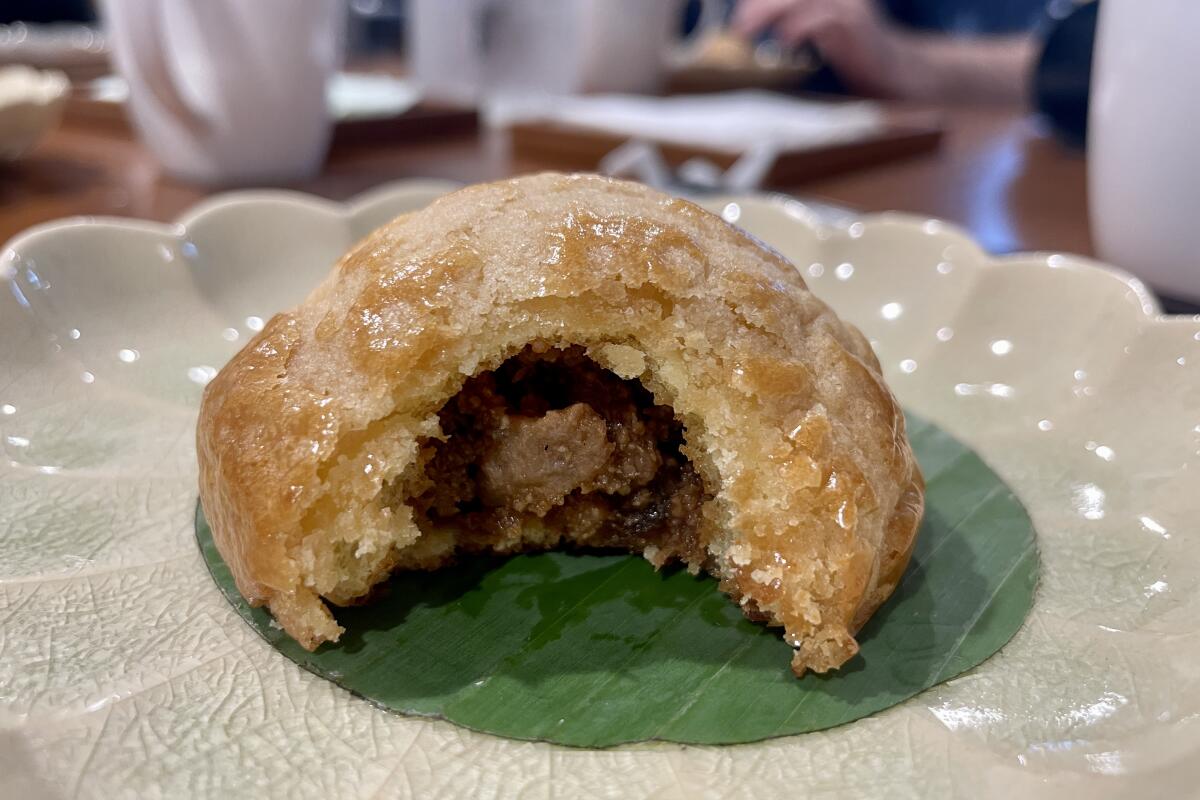
Pang susi from Pangium
11 Gallop Road Gallop Entrance, Singapore Botanic Gardens, Singapore 259015
Phone: +65 8938 3891
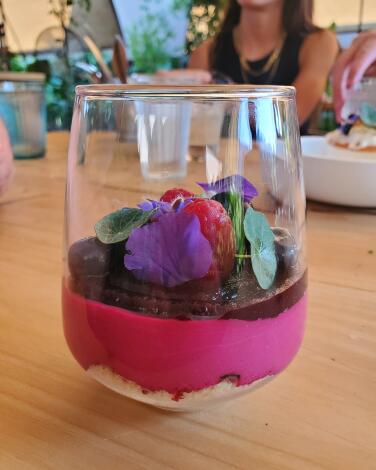
Beet mousse and crumble at Parcela in Tepoztlán
Lately, chilangos have been spreading buzz about a restaurant named Parcela. You can’t get more farm-to-table than this: Parcela (“parcel”) is an outdoor dining space that sits right in the middle of the farm that supplies its kitchen; guests first pass rows of growing corn and greens along a wooden plank walkway to get to a stylish oasis teeming with fronded plants, an attractive bar and a semi-open kitchen. Plates are 100 % seasonal and shifting constantly. When I went in the spring, I was floored by the wallop of flavor contained in this beet mousse over a bread crumble for dessert, topped with berries that were likely still on the vine that very morning. Try everything here — roasts, salads, aguachiles, tostadas — but strategize for a proper round of desserts. This beet mousse was so good, I ordered two.
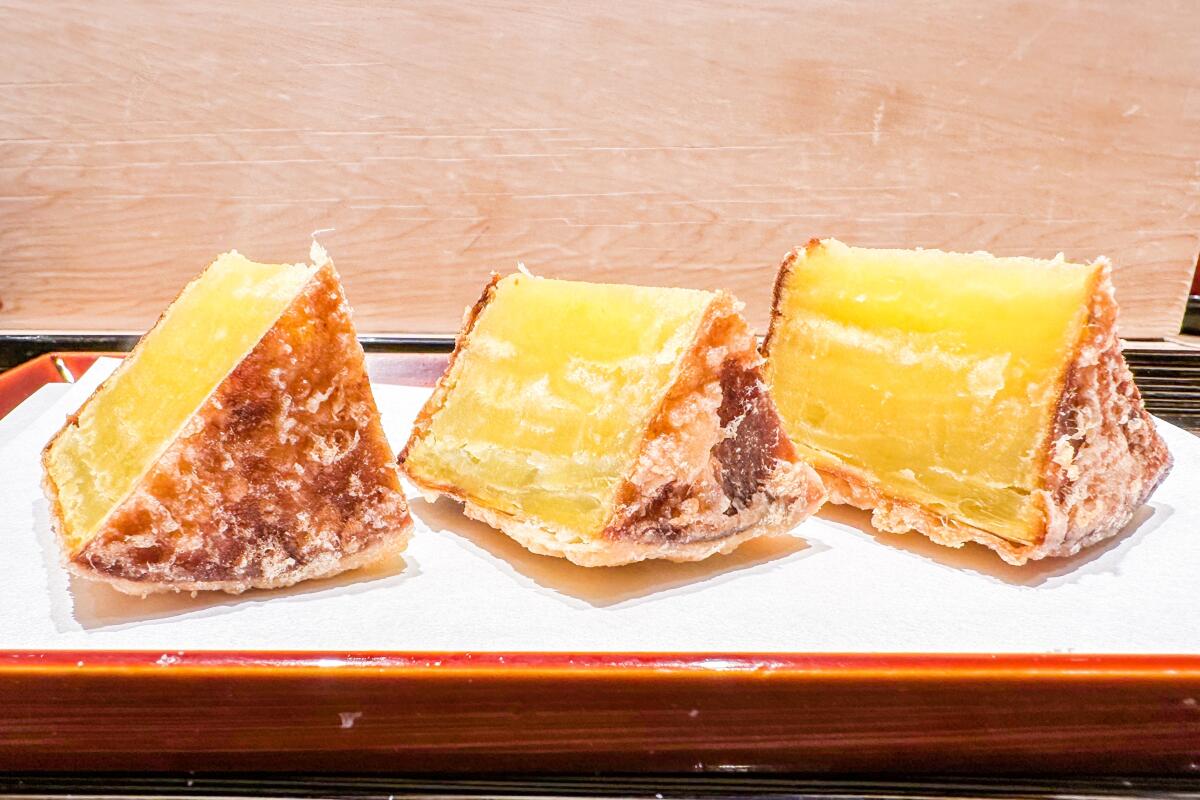
Sweet potato at Tempura Kondo
5-Chome-5-13, Ginza, Chuo City, Tokyo
Phone: +81-3-5568-0923
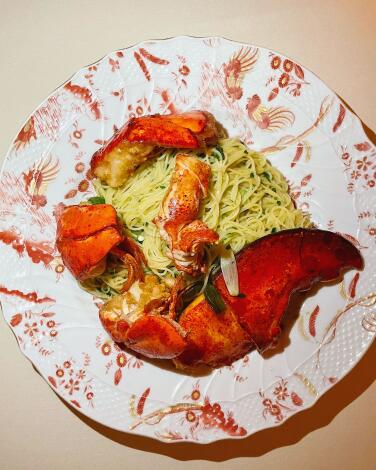
Capellini Cantonese at Torrisi
In their Capellini Cantonese, glossy and fragrant with garlic and ginger and scallions, the iconic Chinese stir-fried, in-shell lobster gets the Italian treatment, and my life is better for it. It’s simple seeming, but don’t let it fool you; this dish incorporates emulsified lobster roe, along with a handful of aromatics that punch up the flavors of butter, sesame oil and olive oil. I’ve tried to re-create this blending of both worlds at home, to no avail, causing me to spiral and scheme over when I could possibly be back in Torrisi’s glowing dining room again.
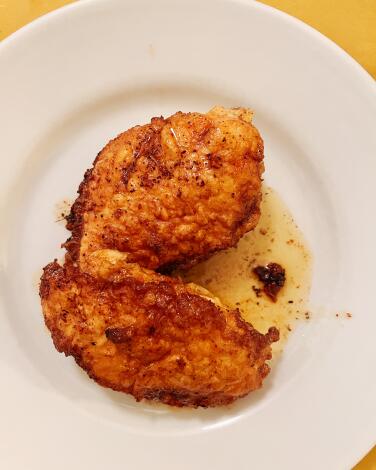
Petti di pollo al burro at Trattoria Sostanza
Via del Porcellana, 25/R, 50123 Florence, Italy
Phone: +39 055 212691
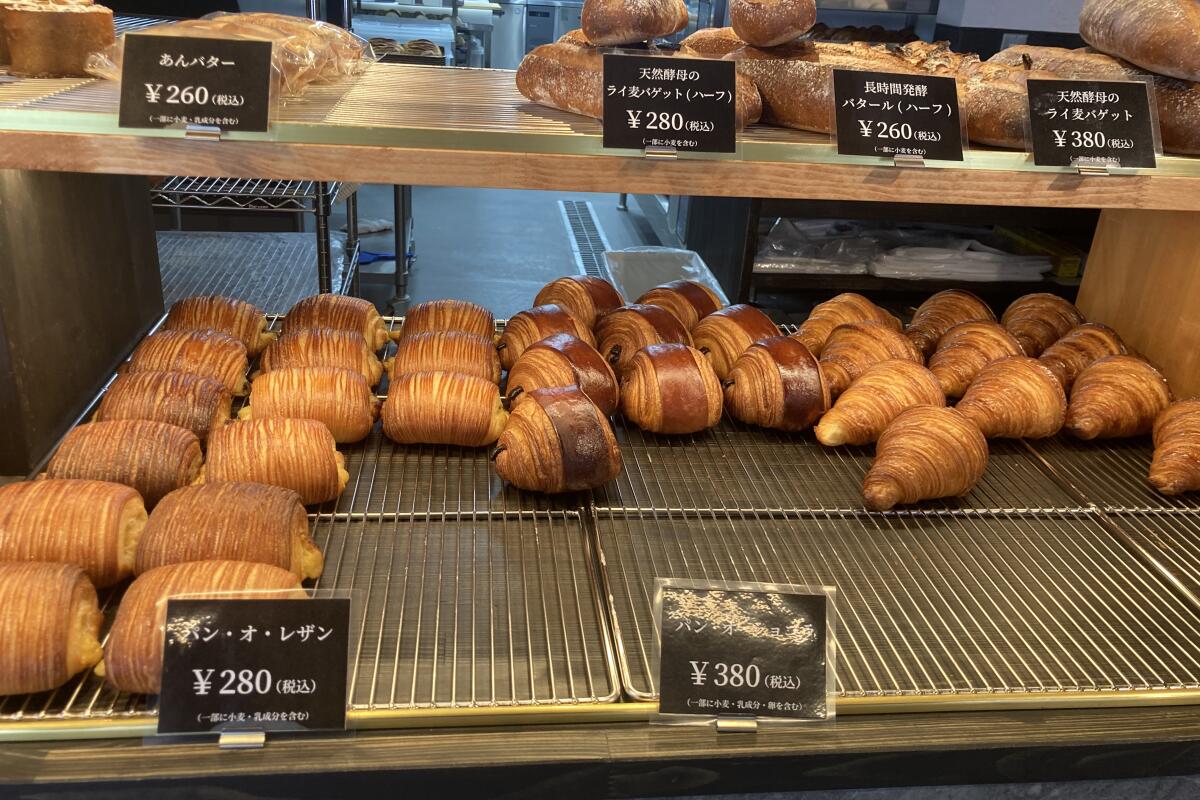
Every croissant from 2/7 Kitchen
207-3 Ayazaimokucho, Shimogyo Ward, Kyoto, 600-8072, Japan
Phone: +81 75 353 1930
No comments:
Post a Comment